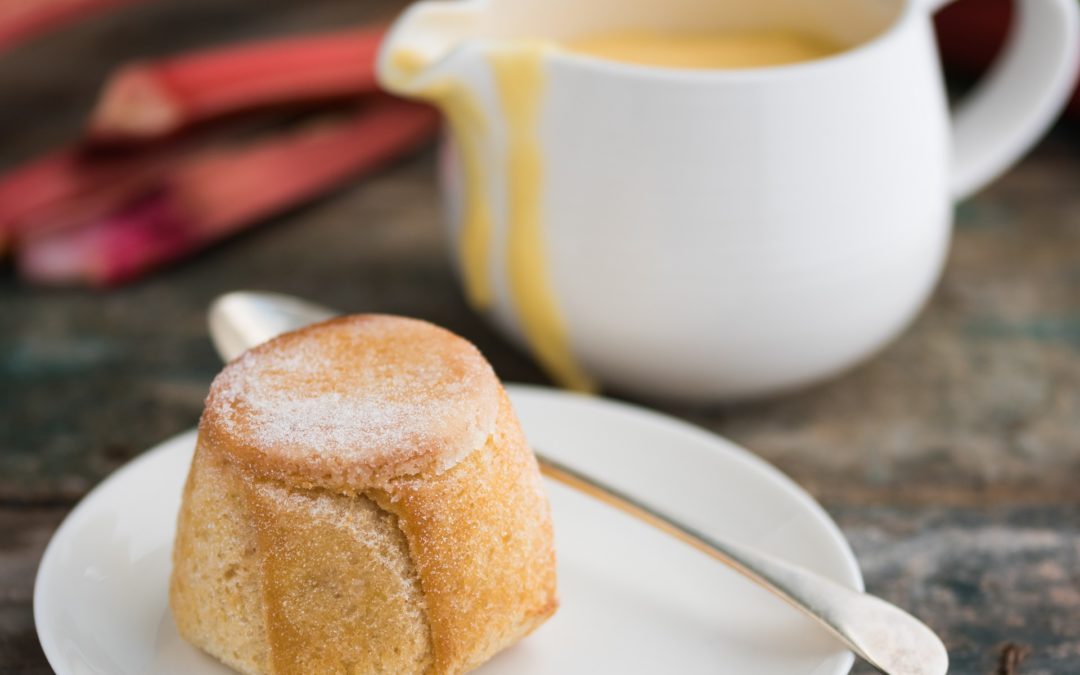Many of us will have heard of an apple charlotte even if we don’t know what it is, and a quick Google search will sadly confirm exactly that. True, it’s an old-fashioned pudding, and as such falls into that category of foods that are humble and unassuming, and which have been forsaken in favour of something less homely.
My version replaces the traditional apple filling with rhubarb, but otherwise follows the same principle; a pudding basin buttered and dusted with sugar, lined with bread and filled with a stewed fruit compote. Sealed and baked in the oven to create a crispy crusty outer shell, which is then turned out and with a bit of luck, drenched with custard.
It’s not a recipe that’ll take kindly to modernisation by the health conscious; it uses butter and sugar and cheap white bread, and that’s the way it has to be. Cheap white bread has a tight crumb structure meaning there are no holes in it (like say, a ciabatta), which makes a better, less permeable medium for sealing in the contents. Brown bread has no place in a dessert quite frankly and anything with seeds and what-have-you will risk sticking or burning to the sides of the mould, like the sultanas that catch on the top of your bread and butter pudding.
My recipe uses individual pudding basins but you could make one large one, and increase the cooking time by 10 minutes.
Ingredients
(makes 6x 175ml individual puddings)
750g rhubarb (prepared weight)
150g caster sugar + a little extra for dusting the pudding basins
1 x white loaf, medium sliced, crusts cut off
200g butter
1 x egg white
1 x teaspoon cornflour mixed with 2 teaspoons cold water
Preheat the oven to 180⁰C.
Start with the rhubarb compote as it needs to cool before filling the puddings.
Wash and dry the rhubarb, then top tail. Cut into small 2cm chunks, then toss together with the sugar in a bowl and distribute evenly in a roasting tin. Roast in the oven for 10 – 12 minutes until tender, testing with the tip of knife.
Pour the contents of the roasting tin into a sieve, sat over a pan to collect the juices. Let the rhubarb drip for 5 minutes then remove the sieve and reheat the juices. Once the juice starts to simmer, add the cornflour and let it thicken at a very gentle simmer for a further 2 mins. Mix with the rhubarb then allow to cool.
Melt the butter slowly in a small pan, then pour off the clear clarified into a wide shallow bowl, such as a soup bowl, leaving behind the milky white solids in the bottom of the pan. Brush the insides of the pudding basins with the melted butter, then sprinkle generously with caster sugar to coat. Tap out any excess into the next basin and repeat.
Use a cookie cutter to cut 6 circles of bread to fit the bottom of the pudding basins. Dip one side of each one in the melted butter and position, buttered side down in the bottom of each basin. Cut the remaining slices of bread into three strips. Dip one side of each strip into the melted butter, and line the sides of the basin, overlapping the base and each previous slice. Leave the overhang to form the lid later.
Lightly beat the egg white with a fork to break it up, then use a pastry brush to seal the internal joints of the bread lined basins.
Fill each pudding basin with the rhubarb compote then fold over the overhang to form a lid. Seal the outside joints with more egg white, and use light pressure, either by hand or with a weighted baking tray to compress the puddings. Leave them for a couple of minutes until they stop springing back.
Place the pudding on a baking tray, cover with baking paper and another baking tray to prevent the puddings from ‘soufflé-ing’ during cooking. Place in the oven for 20 minutes, then remove the top baking tray and return to the oven for another 10 minutes.
Invert the puddings on to a plate to remove them from their basins (you may need to run a knife around the edges). If not serving immediately, reheat uncovered in a hot oven for 8 minutes.

